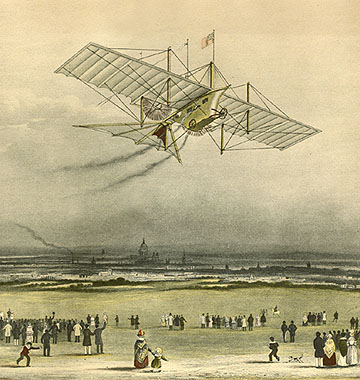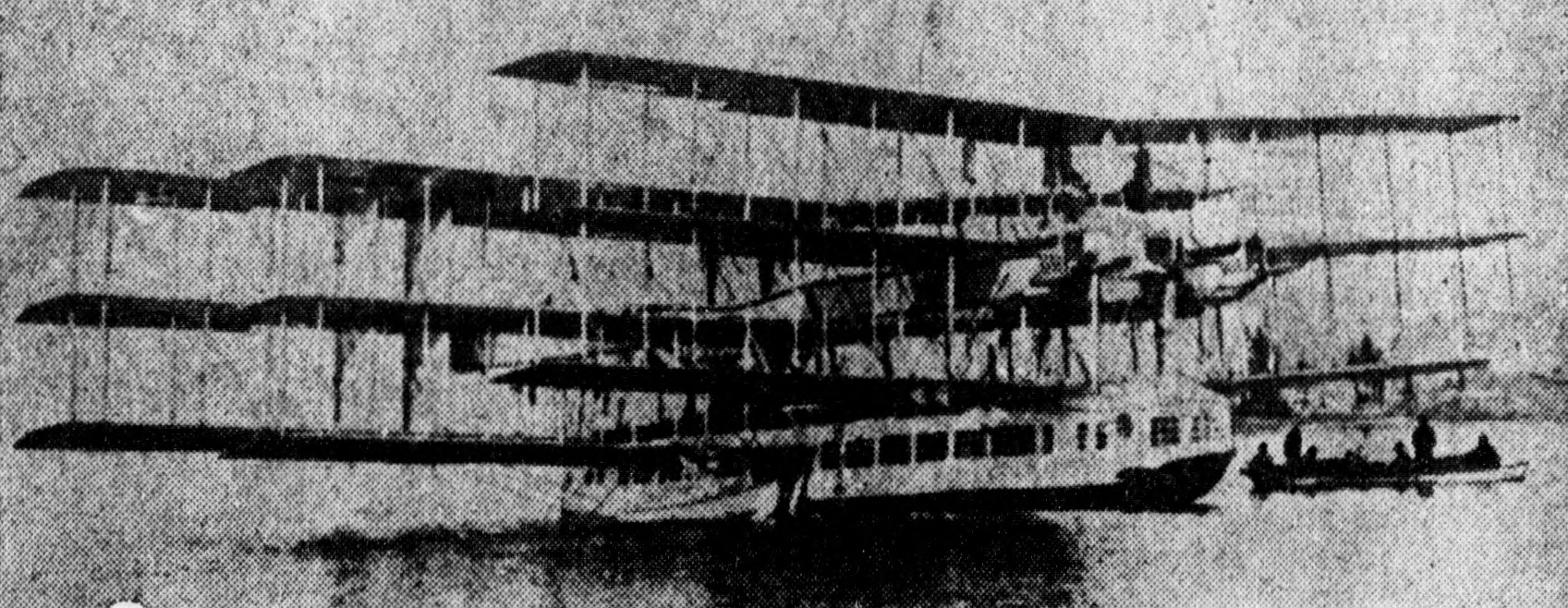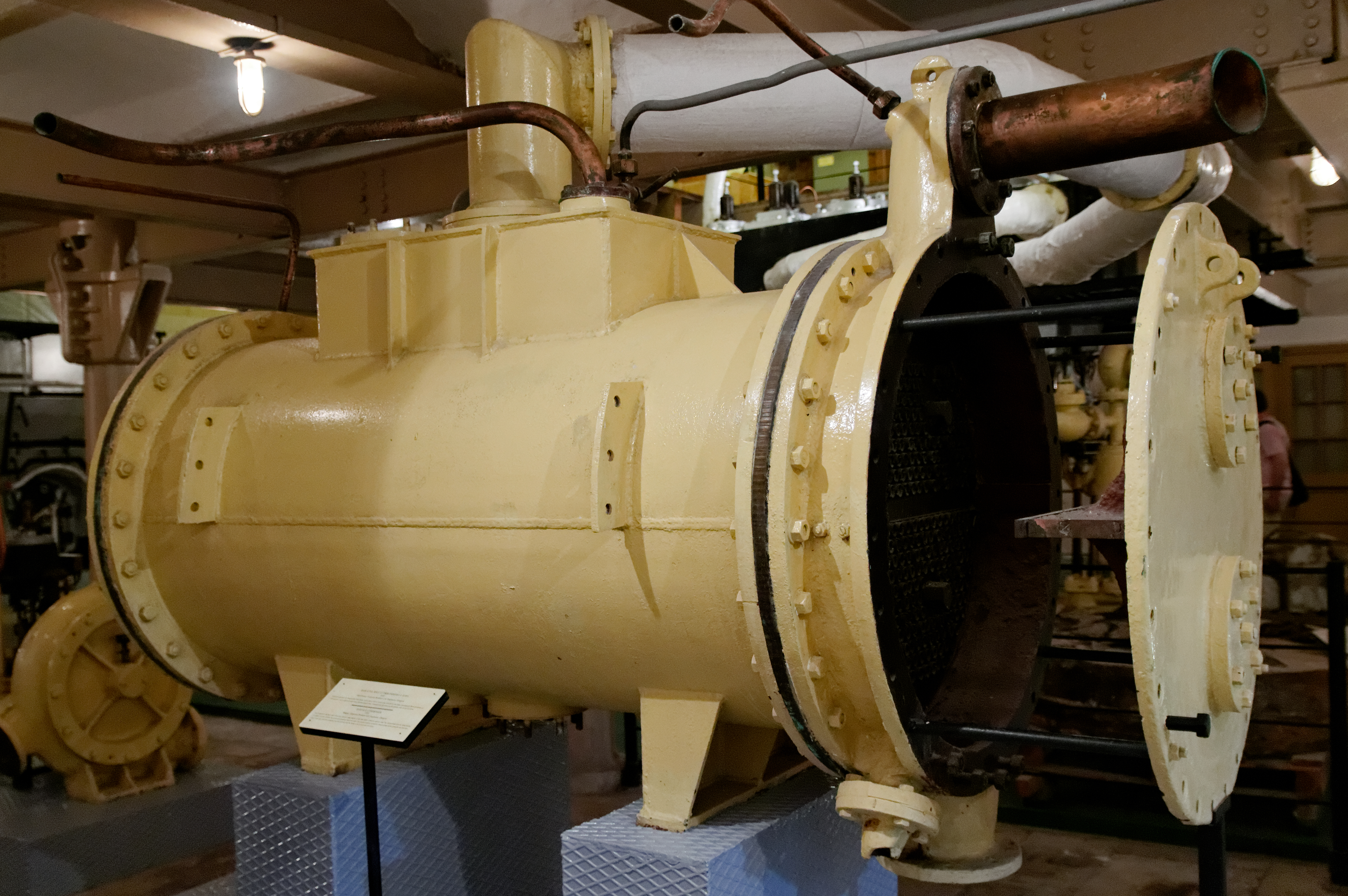|
Bristol Tramp
The Bristol Tramp was a British steam-powered passenger and airmail transport aircraft designed by the Bristol Aeroplane Company. It was built but never flew. Development The Tramp was a development of Bristol's earlier Pullman passenger aircraft. In 1919, Frank Barnwell entered discussions with the Royal Mail Steam Packet Company about the feasibility of using flying boats as auxiliaries to ocean liners. The Royal Mail Steam Packet Company had very limited experience with internal combustion engines, but long-term and deep knowledge of steam turbine powerplants, and so suggested the use of a steam turbine to power the aircraft. As Bristol's heavy bomber, the Braemar – the progenitor of the Pullman – had originally been designed to have a central engine room with driveshafts to wing-mounted propellers, the Pullman seemed a suitable candidate as a testbed for the installation of a steam turbine engine room. The powerplant was to consist of two 1,500 hp (1,120 kW) ... [...More Info...] [...Related Items...] OR: [Wikipedia] [Google] [Baidu] |
WikiProject Aircraft
A WikiProject, or Wikiproject, is a Wikimedia movement affinity group for contributors with shared goals. WikiProjects are prevalent within the largest wiki, Wikipedia, and exist to varying degrees within sister projects such as Wiktionary, Wikiquote, Wikidata, and Wikisource. They also exist in different languages, and translation of articles is a form of their collaboration. During the COVID-19 pandemic, CBS News noted the role of Wikipedia's WikiProject Medicine in maintaining the accuracy of articles related to the disease. Another WikiProject that has drawn attention is WikiProject Women Scientists, which was profiled by '' Smithsonian'' for its efforts to improve coverage of women scientists which the profile noted had "helped increase the number of female scientists on Wikipedia from around 1,600 to over 5,000". On Wikipedia Some Wikipedia WikiProjects are substantial enough to engage in cooperative activities with outside organizations relevant to the field at issue. For e ... [...More Info...] [...Related Items...] OR: [Wikipedia] [Google] [Baidu] |
Flash Boiler
A flash boiler is a type of water-tube boiler. The tubes are close together and water is pumped through them. A flash boiler differs from the type of monotube steam generator in which the tube is permanently filled with water. In a flash boiler, the tube is kept so hot that the water feed is quickly flashed into steam and superheated. Flash boilers had some use in automobiles in the 19th century and this use continued into the early 20th century. History There is disagreement about the exact definition of a flash boiler. Some writers use the term interchangeably with monotube boiler and there is even use of the term ''semi-flash boiler''. However, the flash boiler is generally attributed to Léon Serpollet who used a flash boiler in the Gardner-Serpollet steam-powered car from 1896. Serpollet's boiler was a low-water-content type with thick-walled tubes to provide a store of heat. Serpollet patented a steam generator in 1888, US Patent 379,421, but this is an early version which d ... [...More Info...] [...Related Items...] OR: [Wikipedia] [Google] [Baidu] |
Steam-powered Aircraft
A steam-powered aircraft is an aircraft propelled by a steam engine. Steam power was used during the 19th century, but fell into disuse with the arrival of the more practical internal combustion engine at the beginning of the pioneer era. Steam power is distinct from its use as a lifting gas in thermal airships and early balloons. History * 1842: The Aerial Steam Carriage of William Samuel Henson and John Stringfellow was patented, but was never successful, although a steam-powered model was flown in 1848. * 1852: Henri Giffard flew a 3-horsepower (2 kW) steam-powered dirigible over Paris; it was the first powered aircraft. * 1861 Gustave Ponton d'Amécourt made a small steam-powered craft, coining the name helicopter. * 1874: Félix du Temple flew a steam-powered aluminium monoplane off a downhill run. While it did not achieve level flight, it was the first manned heavier-than-air powered flight. * 1877: Enrico Forlanini built and flew a model steam-powered helicopter ... [...More Info...] [...Related Items...] OR: [Wikipedia] [Google] [Baidu] |
Bristol Aeroplane Company Aircraft
Bristol () is a city, ceremonial county and unitary authority in England. Situated on the River Avon, it is bordered by the ceremonial counties of Gloucestershire to the north and Somerset to the south. Bristol is the most populous city in South West England. The wider Bristol Built-up Area is the eleventh most populous urban area in the United Kingdom. Iron Age hillforts and Roman villas were built near the confluence of the rivers Frome and Avon. Around the beginning of the 11th century, the settlement was known as (Old English: 'the place at the bridge'). Bristol received a royal charter in 1155 and was historically divided between Gloucestershire and Somerset until 1373 when it became a county corporate. From the 13th to the 18th century, Bristol was among the top three English cities, after London, in tax receipts. A major port, Bristol was a starting place for early voyages of exploration to the New World. On a ship out of Bristol in 1497, John Cabot, a Venetian, b ... [...More Info...] [...Related Items...] OR: [Wikipedia] [Google] [Baidu] |
1920s British Airliners
Nineteen or 19 may refer to: * 19 (number), the natural number following 18 and preceding 20 * one of the years 19 BC, AD 19, 1919, 2019 Films * ''19'' (film), a 2001 Japanese film * ''Nineteen'' (film), a 1987 science fiction film Music * 19 (band), a Japanese pop music duo Albums * ''19'' (Adele album), 2008 * ''19'', a 2003 album by Alsou * ''19'', a 2006 album by Evan Yo * ''19'', a 2018 album by MHD * ''19'', one half of the double album ''63/19'' by Kool A.D. * ''Number Nineteen'', a 1971 album by American jazz pianist Mal Waldron * ''XIX'' (EP), a 2019 EP by 1the9 Songs * "19" (song), a 1985 song by British musician Paul Hardcastle. * "Nineteen", a song by Bad4Good from the 1992 album ''Refugee'' * "Nineteen", a song by Karma to Burn from the 2001 album ''Almost Heathen''. * "Nineteen" (song), a 2007 song by American singer Billy Ray Cyrus. * "Nineteen", a song by Tegan and Sara from the 2007 album '' The Con''. * "XIX" (song), a 2014 song by Slipknot. ... [...More Info...] [...Related Items...] OR: [Wikipedia] [Google] [Baidu] |
Farnborough Airfield
Farnborough Airport (previously called: TAG Farnborough Airport, RAE Farnborough, ICAO Code EGLF) is an operational business/executive general aviation airport in Farnborough, Rushmoor, Hampshire, England. The airport covers about 8% of Rushmoor's land area. Farnborough Aerodrome has a CAA Ordinary Licence (Number P864) that allows flights for the public transport of passengers or for flying instruction as authorised by the licensee (TAG Farnborough Airport Limited). The first powered flight in Britain was at Farnborough on 16 October 1908, when Samuel Cody took off in his British Army Aeroplane No 1. The airfield is the home of the Farnborough Airshow which is held in even numbered years. It is also home to the Air Accidents Investigation Branch, part of the Department for Transport. History Farnborough Airport has a long history, beginning at the start of the 20th century with the creation of His Majesty's Balloon Factory and the first powered flight in Britain in 1908 ... [...More Info...] [...Related Items...] OR: [Wikipedia] [Google] [Baidu] |
Piston Engine
A reciprocating engine, also often known as a piston engine, is typically a heat engine that uses one or more reciprocating pistons to convert high temperature and high pressure into a rotating motion. This article describes the common features of all types. The main types are: the internal combustion engine, used extensively in motor vehicles; the steam engine, the mainstay of the Industrial Revolution; and the Stirling engine for niche applications. Internal combustion engines are further classified in two ways: either a spark-ignition (SI) engine, where the spark plug initiates the combustion; or a compression-ignition (CI) engine, where the air within the cylinder is compressed, thus heating it, so that the heated air ignites fuel that is injected then or earlier.''Thermodynamics: An Engineering Approach'' by Yunus A. Cengal and Michael A. Boles Common features in all types There may be one or more pistons. Each piston is inside a cylinder, into which a gas is intro ... [...More Info...] [...Related Items...] OR: [Wikipedia] [Google] [Baidu] |
Siddeley Puma
The Siddeley Puma was a British aero engine developed towards the end of World War I and produced by Siddeley-Deasy. The first engines left the production lines of Siddeley-Deasy in Coventry in August 1917, production continued until December 1918. At least 4,288 of the 11,500 ordered engines were delivered, orders were cancelled following the Armistice with Germany (Compiègne), Armistice. Production was continued under the name Armstrong Siddeley Puma when the manufacturer was bought by Armstrong Whitworth and became Armstrong Siddeley. The engine was based on a previous Beardmore Halford Pullinger, B.H.P engine which was also developed as the Galloway "Adriatic." Applications *The Puma engine was used in the British World War I bomber aircraft, the Airco D.H.9. In use it proved to be highly troublesome, making the aircraft significantly inferior to the type it replaced. The engine was also installed untidily, with the cylinder heads protruding. The D.H.9, as a type, was impr ... [...More Info...] [...Related Items...] OR: [Wikipedia] [Google] [Baidu] |
1921 In Aviation
This is a list of aviation-related events from 1921: Events * Mexicana de Aviación begins service. * The Imperial Japanese Navy acquires its first rigid and semi-rigid airships. * The Italian General Giulio Douhet publishes his highly influential book ''Command of the Air''. In it, he argues that the ability of aircraft to fly over armies and navies renders those forces of secondary importance; that the vastness of the sky makes defense against bombers impossible; that only offensive bombing to destroy the enemys air force can allow a country to achieve command of the air; that once it is achieved, a bombing campaign can be carried out against enemy "vital centers", including industry, transportation, government, communications, and "the will of the people;" and that success against enemy civilian morale in particular would be the key to victory. * When the Italian Chief of the Naval Staff Admiral Paolo Thaon di Revel argues for the development of aircraft carriers, saying "t ... [...More Info...] [...Related Items...] OR: [Wikipedia] [Google] [Baidu] |
Surface Condenser
A surface condenser is a water-cooled shell and tube heat exchanger installed to condense exhaust steam from a steam turbine in thermal power stations. These condensers are heat exchangers which convert steam from its gaseous to its liquid state at a pressure below atmospheric pressure. Where cooling water is in short supply, an air-cooled condenser is often used. An air-cooled condenser is however, significantly more expensive and cannot achieve as low a steam turbine exhaust pressure (and temperature) as a water-cooled surface condenser. Surface condensers are also used in applications and industries other than the condensing of steam turbine exhaust in power plants. Purpose In thermal power plants, the purpose of a surface condenser is to condense the exhaust steam from a steam turbine to obtain maximum efficiency, and also to convert the turbine exhaust steam into pure water (referred to as steam condensate) so that it may be reused in the steam generator or boiler as boiler ... [...More Info...] [...Related Items...] OR: [Wikipedia] [Google] [Baidu] |
Liberty L-12
The Liberty L-12 is an American water-cooled 45° V-12 aircraft engine displacing and making designed for a high power-to-weight ratio and ease of mass production. It saw wide use in aero applications, and, once marinized Marinisation (also marinization) is design, redesign, or testing of products for use in a marine environment. Most commonly, it refers to use and long-term survival in harsh, highly corrosive salt water conditions. Marinisation is done by many manu ..., in marine use both in racing and runabout boats. A single bank 6-cylinder version, the Liberty L-6, and V-8, the Liberty L-8, were derived from the Liberty L-12. It was succeeded by the Packard 1A-2500. Development In May 1917, a month after the United States had declared war on Germany, a federal task force known as the Aircraft Board, Aircraft Production Board summoned two top engine designers, Jesse G. Vincent (of the Packard Motor Car Company of Detroit) and Elbert J. Hall (of the Hall-Scott Motor Co. ... [...More Info...] [...Related Items...] OR: [Wikipedia] [Google] [Baidu] |
Triplane
A triplane is a fixed-wing aircraft equipped with three vertically stacked wing planes. Tailplanes and canard foreplanes are not normally included in this count, although they occasionally are. Design principles The triplane arrangement may be compared with the biplane in a number of ways. A triplane arrangement has a narrower wing chord than a biplane of similar span and area. This gives each wing-plane a slender appearance with higher aspect ratio, making it more efficient and giving increased lift. This potentially offers a faster rate of climb and tighter turning radius, both of which are important in a fighter. The Sopwith Triplane was a successful example, having the same wing span as the equivalent biplane, the Sopwith Pup. Alternatively, a triplane has reduced span compared to a biplane of given wing area and aspect ratio, leading to a more compact and lightweight structure. This potentially offers better maneuverability for a fighter, and higher load-capacity wit ... [...More Info...] [...Related Items...] OR: [Wikipedia] [Google] [Baidu] |








.jpg)